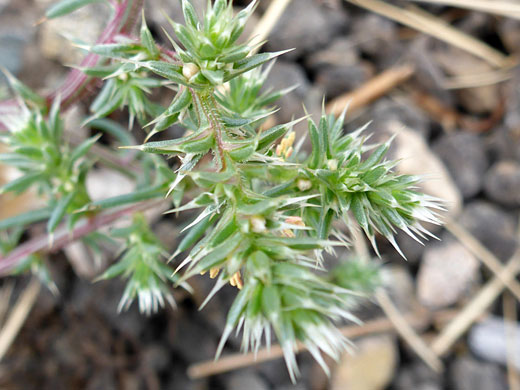Common names:
Prickly russian thistle, tumbleweed
Family:
Scientific name:
Salsola tragus
Synonym:
Kali tragus
Main flower color:
Range:
All the western states (non native)
Height:
Up to 3.5 feet
Habitat:
Roadsides, fields, coastal margins, sandy places; sea level to 8,200 feet
Leaves:
Alternate, linear, thick, up to 2 inches long, topped by a white spine
Season:
July to October
Salsola tragus is the most widespread of eight species of this non-native genus to have become established in the US, after being introduced in the 1870s. Plants branch profusely, forming dense clumps, several feet high and wide. Leaves are clustered, linear to thread-like, and terminate in a spike. Towards the end of the branches they merge with bracts, similar in appearance, though shorter, and with a longer, wider spine.
Stems are green or reddish, often striped, either green/red or white/red. Stems may be glabrous or sparsely covered with short, rigid hairs. After flowering and withering, the dried stems readily break at ground level allowing them to be moved by the wind; this is one of several species known as tumbleweeds.
Flowers are produced singly at the base of the bracts, forming a narrow, elongated cluster. Flowers have no petals, instead a ring of thin, papery sepals, pink towards the middle otherwise white. Five short stamens radiate from the center.
Stems are green or reddish, often striped, either green/red or white/red. Stems may be glabrous or sparsely covered with short, rigid hairs. After flowering and withering, the dried stems readily break at ground level allowing them to be moved by the wind; this is one of several species known as tumbleweeds.
Flowers are produced singly at the base of the bracts, forming a narrow, elongated cluster. Flowers have no petals, instead a ring of thin, papery sepals, pink towards the middle otherwise white. Five short stamens radiate from the center.
All Contents © Copyright The American Southwest | Comments and Questions | Contribute | Site Map



